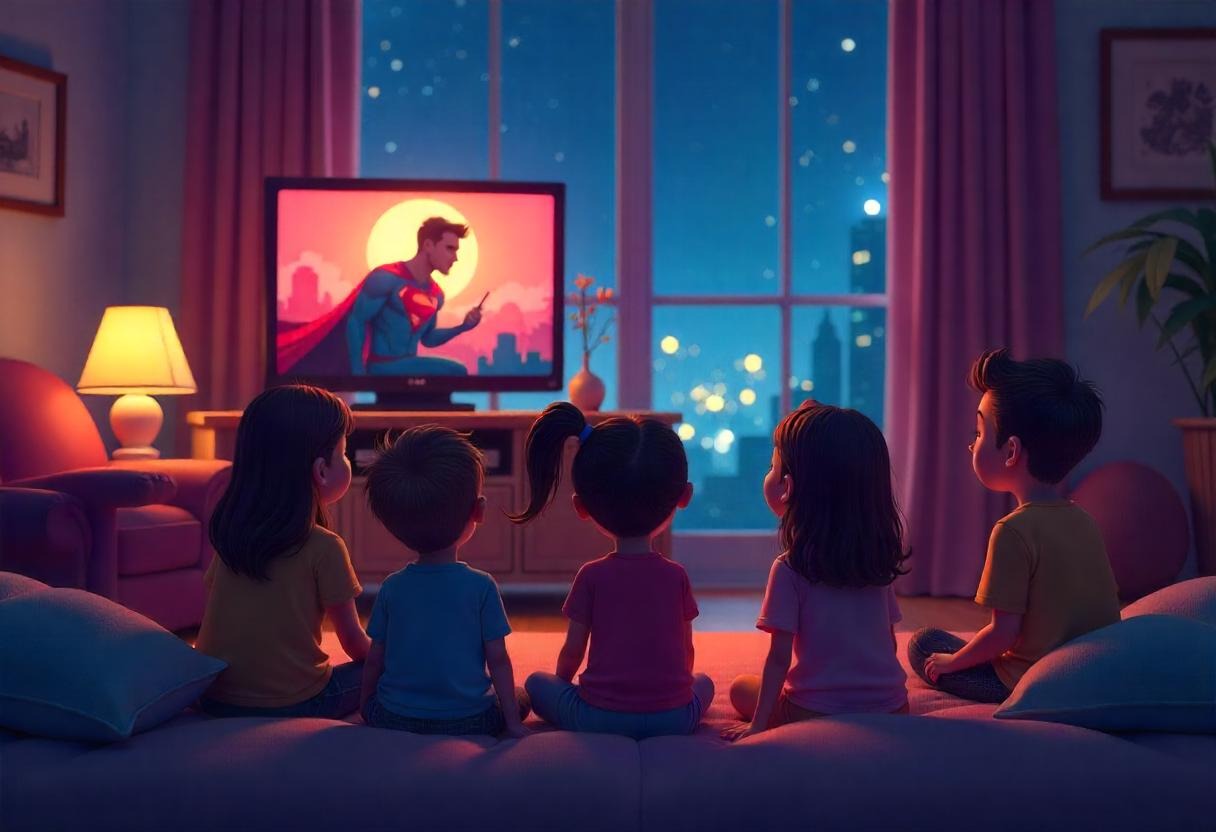Stranger Things? No, stranger brands.
That’s what happens when you pick the wrong archetype.
Your video ends up in the Upside Down of branding. Engagement vanishes faster than Barb. Even Eleven’s powers can’t save your ROI.
Brand archetypes are personality traits that humanize your brand. Each defines and expresses distinctive identities and hits unique emotions.
It acts as a guideline for your visual and verbal identity. And this makes you instantly relatable to your favorite people.
If you wish to hack the minds of your audience, know the examples! They’ll give you an idea of which archetype aligns with your messaging and values.
That way, you get to:
- Create a consistent brand experience and
- Connect with the audience emotionally
Although there are countless archetypes, brands embrace 10 of them.
Among these, the top 5 brand archetype examples are: Everyman, hero, caregiver, sage, and jester.
They can all effectively influence consumer behavior.
Brand Archetype Wheel

1. The Everyman Archetype
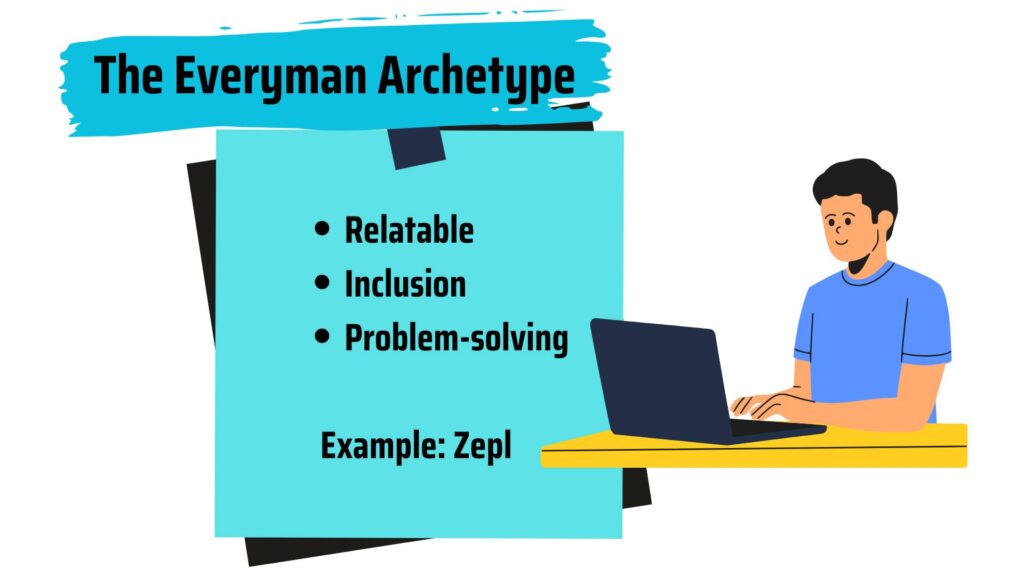
What does it stand for?
- Relatable, approachable, and practical
- Makes you feel comfy and included
- Entices everyday people looking for reliable solutions
Overview
This one focuses on belonging.
Brands that follow this strategy want to connect with everyday people. They want to make the audience feel valued just as they are.
So, they make videos that feel approachable and solution-focused.
Everyman brand archetype typically invites viewers to see themselves in the story. When promoting products, they typically follow one common format–
- Addressing the relatable problem
- Presenting their items as a solution
According to the “State of the Connected Customer” report by Salesforce:
“73% expect companies to understand their unique needs”
Example | Zepl
Although “every day” is the IKEA brand archetype, we think Zepl is another good example.
It’s a cloud-based data science platform.
The software lets the team use data science to analyze the cloud data warehouse in minutes. Plus, it addresses multiple AI data management issues and provides data science solutions to solve them.
Ad
For instance, the Zepl animated explainer by LocalEyes.
The video simplifies complex topics through creative visuals and relatable stories.
It highlights teams’ problems they face when managing data and how the software helps.
2. The Innocent Archetype
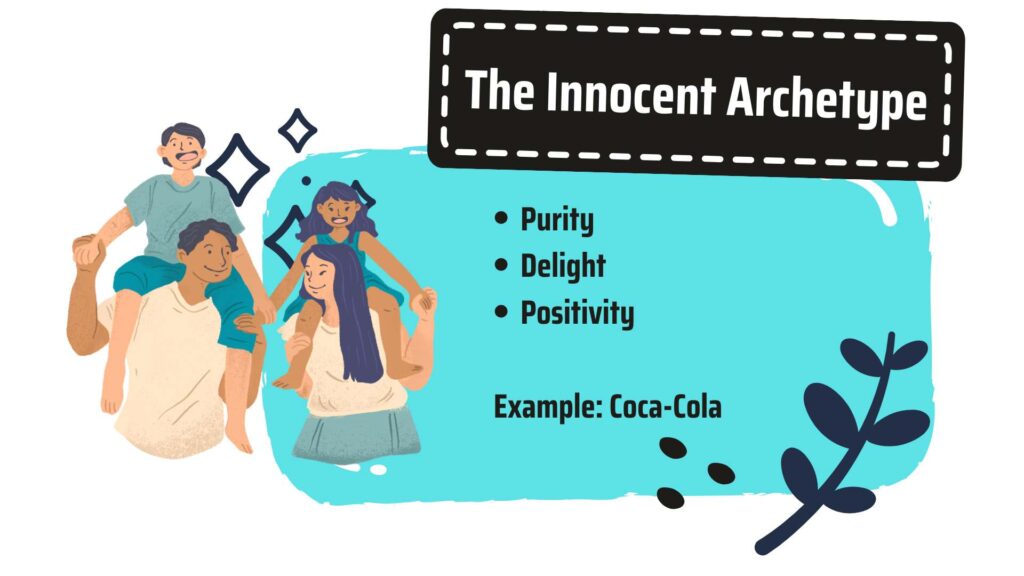
What does it stand for?
- Pure, happy, and optimistic
- Believes in goodness, simplicity, and positivity
- Attracts people looking for a feel-good, wholesome experience
Overview
Brands that represent the innocent archetype stir a sense of nostalgia and delight.
Their marketing often encourages us to look at the brighter side of things. The content makes us feel safe.
Such an archetype focuses on all positive things to have our inner child scream.
A study by Nielsen found that–
- “Emotional ads help increase sales by 23%.”
Example | Coca-Cola
Coca-Cola is a classic example of an innocent brand archetype.
Ever seen a Coke ad without smiles, happy families, or holiday magic? Never.
The brand often releases video ads that emphasize themes of happiness and togetherness.
Their ad mostly features people enjoying time with friends, family, and other people. And they celebrate it with drink whether during holidays, gatherings, or celebrations.
Ad
For instance, one of their famous campaigns is Share A Coke. It perfectly goes with this archetype.
Individuals find joy while interacting with even strangers. That’s the Coca-Cola brand archetype for you.
Statista says that:
Coca-Cola spends over $4 billion a year just to maintain this positive, innocent brand image.
3. The Hero Archetype
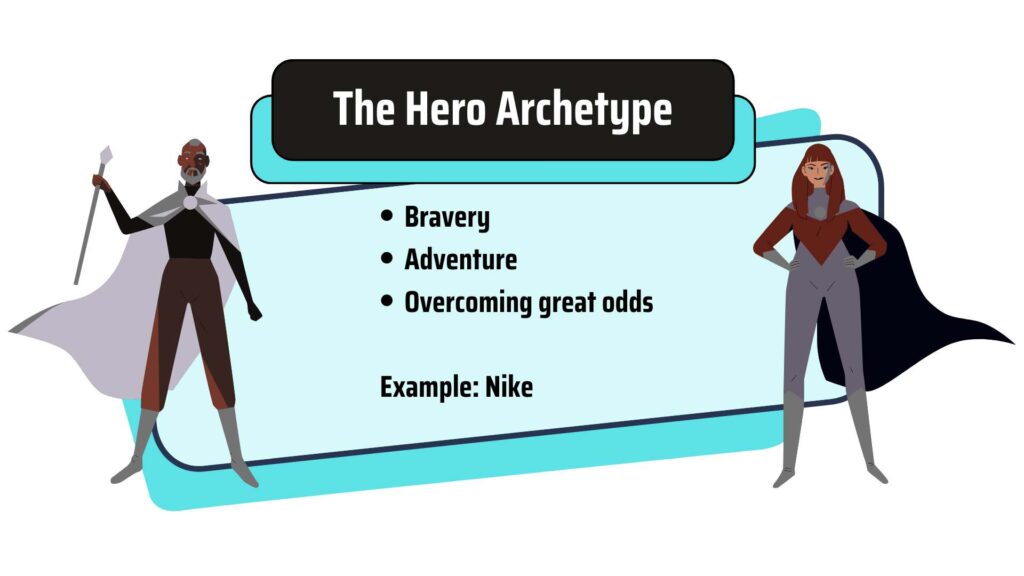
What does it stand for?
- Courage, determination, and mastery
- Inspires people to be their best selves
- Attracts go-getters and ambitious personalities
Overview
Brands that align with this archetype are like motivators.
They inspire us to overcome obstacles and reach our goals. Plus, they want us to feel strong and confident.
Research says–
The Hero’s Journey Framework can help marketers create more engaging stories to resonate with audiences.
Check out any hero brand archetype examples. They’ll make you feel that “you can be the hero of your own story!”
Not just that! Their struggles will make you root for them and stay intrigued.
Example | Nike
Nike beautifully exemplifies the Hero archetype.
Their iconic slogan, “Just Do It” says it all. It encourages action and represents strength and determination.
Nike’s ads and videos often show athletes powering through challenges. The content highlights their personal growth and achievements.
Ad
For instance, their “Winning Isn’t For Everyone” campaign.
It features athletes like Qinwen Zheng, Sha’Carri Richardson, and LeBron James.
The ads show their sacrifice, struggles, and obstacles and how their perseverance helps them conquer those.
So, Nike doesn’t just sell sportswear. They sell a lifestyle that promotes empowerment. Because of this archetype, they often celebrate market dominance.
A study mentioned that:
- Nike’s brand value increased by 15% in a single quarter because of the “Find Your Greatness” campaign.
4. The Outlaw Archetype
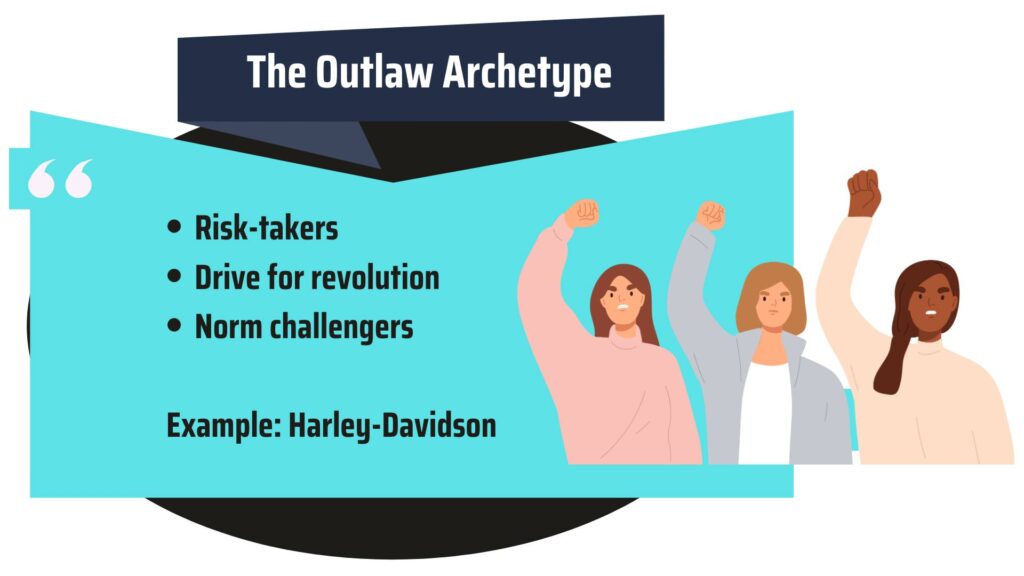
What does it stand for?
- Rebellious, rule-breakers, and risk-takers
- Creates a strong, loyal tribe of customers
- Intrigues those who challenge the norm
Overview
Let’s take a walk on the wild side of the Outlaw brand archetype!
Brands with such an archetype focus on rebellion and desire for change.
With this spirit, they target audiences who:
- Want to be themselves and avoid following the crowd.
- Enjoy adventure
- Celebrate bold choices
- Want to express individuality
Rebellious essence can efficiently draw people in. It’s mostly because they challenge norms and support social or political causes.
A survey by Havas found that–
53% of the participants would like to pay more for a brand that takes a stand.
Example | Harley-Davidson
Harley-Davidson brand archetype falls into the outlaw category.
The motorcycle brand carries freedom and a rebellious spirit. This is what we mostly see in their ads.
The advertising videos consistently portray themes of:
- Adventure and
- Breaking the rules
Their slogan, “Live to Ride, Ride to Live,” captures that vibe. It shows how riders embrace freedom on the road.
With this approach, the brand relishes positive ROI. As per Statista:
“Their global revenue increased by 1.1 percent in 2023.” It’s pretty good.
Ad
For instance, their Breathe commercial.
The ad starts with a voice that lists multiple dos and don’ts to an irritating point.
It rebels against the pressure that comes from the daily tasks. Instead, the voice tells us to take a break, relax, and breathe.
5. The Caregiver Archetype
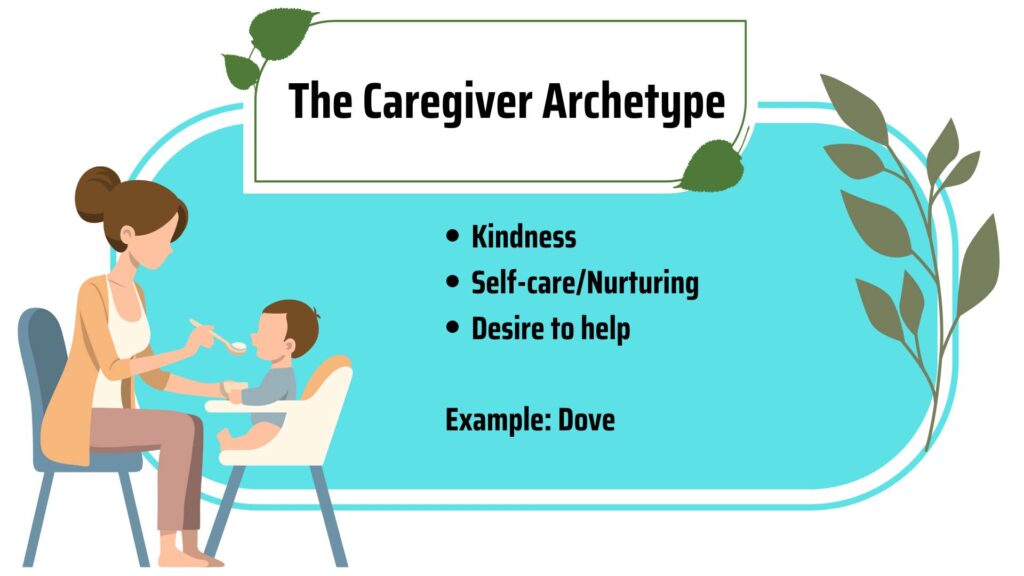
What does it stand for?
- Compassion, kindness, and protection
- Caring for people
- Appeals to those who value warmth and trust
Overview
The caregiver archetype has this softness that wins people over.
Brands with this archetype look for ways to help people. They want to create a feeling of comfort and safety.
The focus is on one thing:
- Building trust with their customers
If you watch any caregiver brand archetype examples, notice that they mainly promote messages of–
- Self-love, community, and caring for one another
Example | Dove
A prominent caregiver archetype is Dove.
The brand consistently releases commercials and short films. These videos depict how they challenge traditional beauty standards. They show real women of all shapes, sizes, and ages and work to empower them.
With this, they aim to create a sense of belonging for everyone.
The biggest weapon is their “Real Beauty” campaign. With this, the brand promotes:
- Self-care and
- Empowerment
One research on the Dove Campaign highlighted that:
Positive word-of-mouth helps people connect with the brand.
Factors like emotional attachment to the cause, brand trust, and a sense of community all improve attitudes toward Dove and its campaign.
And this is what they focus on.
Ad
For instance: Dove Toxic Influence
In this short film, mothers and daughters confront damaging beauty standards perpetuated online.
It has highlighted real people and their opinions on toxic influence. Their real-life experiences and concerns are what work for viewers.
6. The Magician Archetype
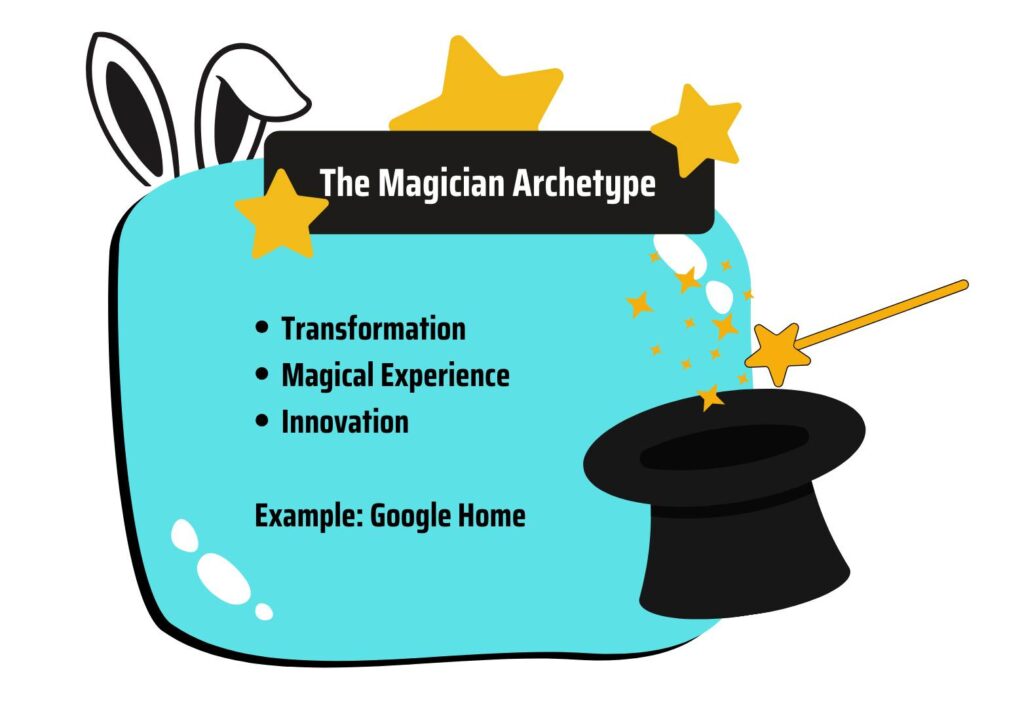
What does it stand for?
- Wonder, transformation, and dreams coming true
- Creates an escape from reality
- Intrigues those who believe in possibilities
Overview
It’s all about sea change. Brands that follow this archetype aim to:
- Create magical experiences and
- Inspire their audiences through surprising factors
They focus on the possibility of change and help consumers realize their potential.
When it’s a magician brand archetype, know that you’ll see the extraordinary in the ordinary as consumers.
There’s an article that talks about how ads turn regular products into something special. It says:
“Advertising acts like magic as it works to boost people’s hopes and confidence.”
The content in commercials shapes our thinking and social norms. This helps us stay optimistic about our desires.
Example | Google Home
Of course, the magician is the Disney brand archetype.
However, Google Home takes the cake, too. It’s not just a speaker. The product changes the entire appearance of your home and makes it SMART.
It lets you use your voice to play media, manage tasks, and control smart devices. This is the magical experience Google Home provides.
Ad
Google Home TV Spot, ‘The Magic Word: YouTube Trial’
For instance, Google Home The Magic Word Ad.
Here, a little wizard tries out multiple spells on a quizzical pup. Sadly, they don’t work.
Google Home chimes in with a secret and tells him to say the magic word: please. Then, the magic happens, and the pup responds.
This shows that Google Home can even make your favorite pet listen to you.
7. The Lover Archetype

What does it stand for?
- Passion, romance, and beauty
- Makes you feel powerful and irresistible
- Targets those who crave emotion and sensuality
Overview
Let’s fall into the category of the lover archetype.
This one centers around passion, intimacy, and deep emotional connections. Brands work to evoke feelings of romance and desire.
They want to create:
- Strong emotional bonds with viewers and
- Seductive and self-love experiences
This allows viewers to connect with their emotions and, eventually, the brand.
As per data by BB Media–
“Engagement with the romance content stood at 33.9% in Q2 2024.”
Although it dropped from 38.7% in Q2 2022, the percentage still indicates a good prevalence of the genre.
Example | Victoria’s Secret
Victoria’s Secret is the perfect lover brand archetype.
The brand specializes in lingerie and beauty products. They promote allure and sensuality that work to hook the right audiences.
Their ads often feature amazing diverse models, luxurious designs, and dreamy settings.
This helps:
- Reach wider customers and
- Persuade them to try a luxurious lifestyle
Statista shows that–
34% of online American fashion shoppers like VS, 27% use it, and 22% would like to use it again.
Ad
For instance, their What is Love ad.
This is a perfect commercial example of the Victoria’s Secret brand archetype. It focuses on self-love and the presence of love in everyday life.
The ad features diverse models so the viewers find them relatable and feel involved.
8. The Jester Archetype
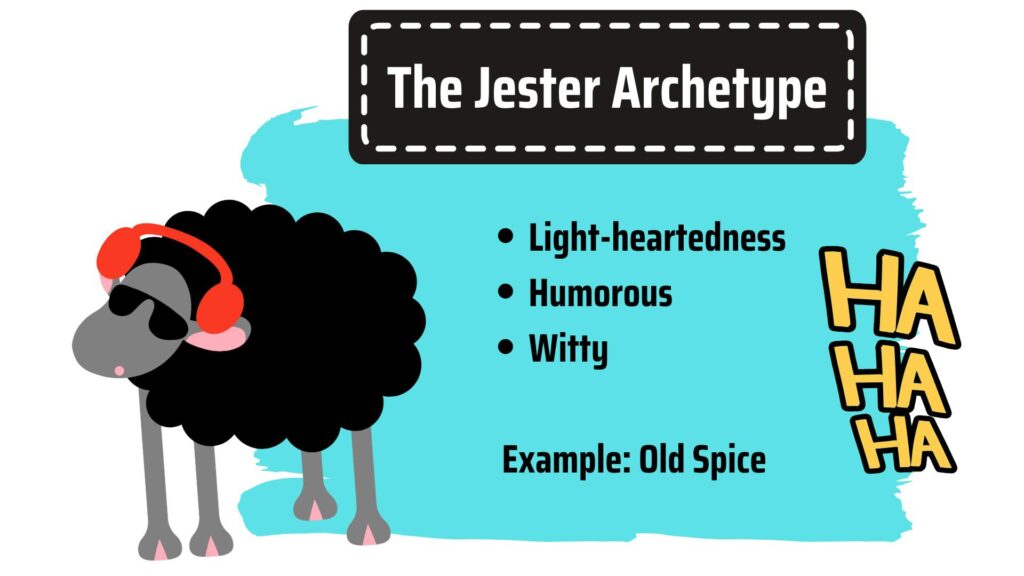
What does it stand for?
- Fun, humor, and lightheartedness
- Keep people engaged
- Attract those who love to laugh and enjoy life
Overview
The Jester brand archetype is there just to be hilarious. Brands infuse a blend of creativity, jokes, wit, comedy, and humor to entertain and hook their audiences.
They remind us not to take life too seriously and create light-hearted experiences for viewers.
The toughest job for brands is actually to make people laugh.
As per the Global Report shared by PRN,
“88% keep looking for new experiences to laugh.”
The TG is wide, so brands that actually can make people smile enjoy lots of profits.
Example | Old Spice
The Old Spice brand archetype belongs to the jester genre.
They create a playful brand image that reaches people efficiently.
Their videos have several humorous factors: funny voices, weird actors, witty slogans, and hilarious storytelling.
All these work to engage the viewers.
A case study mentions that:
Because of their ‘The Man Your Man Could Smell Like’ campaign, they relished a 125% increase in sales.
That’s huge! Their campaign title explains how it worked.
Ad
For instance, this campaign-titled ad.
They aren’t saying their body wash will make your man smell like a “romantic millionaire jet fighter pilot”; they’re just insinuating it.
That’s their punch!
The lines, actors, and presentations all just work to bring a big grin to your face.
9. The Sage Archetype
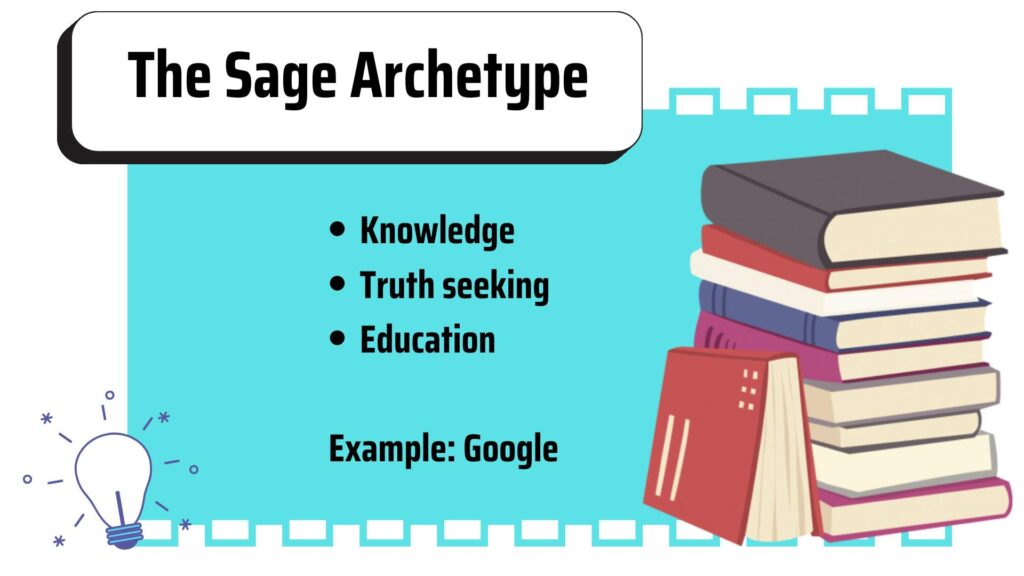
What does it stand for?
- Knowledge, wisdom, and truth
- Sharing the world’s information
- Intrigues those who are seeking reliable information and data
Overview
Let’s explore this one now.
The sage brand archetype includes wisdom and truth-seeking. Businesses in this category have one specific goal:
- To educate and inspire their viewers
They often serve as guides. This helps humans understand complex information and make proper decisions.
Wisdom is power. The more you have, the more powerful you are.
The majority of Americans seek extra knowledge for personal and work-related reasons.
Pew Research Center mentions:
80% of personal learners chase knowledge based on their interests to make life more interesting.
The audience base is broader than you think. That’s why brands like Google and Wikipedia have countless consumers.
Example | Google
The sage theme perfectly fits the Google brand archetype.
This brand is like a whole new planet. Because they hold unlimited resources, data, and information beyond our imagination.
It provides us access to the world of knowledge right at our fingertips.
Whether it is facts or learning something new, they inspire us to stay curious and informed.
As we mentioned, Google has lots of people as its customers. Research by Exploding Topics highlights that:
- “There are around 5 billion Google users worldwide”
Ad
For instance, Google has a beautiful video called Year in Search.
It explores the searches and trends that shaped 2024. The video also reveals surprises no one actually saw coming.
The fun fact is that they don’t even use many ads to promote their products.
10. The Ruler Archetype
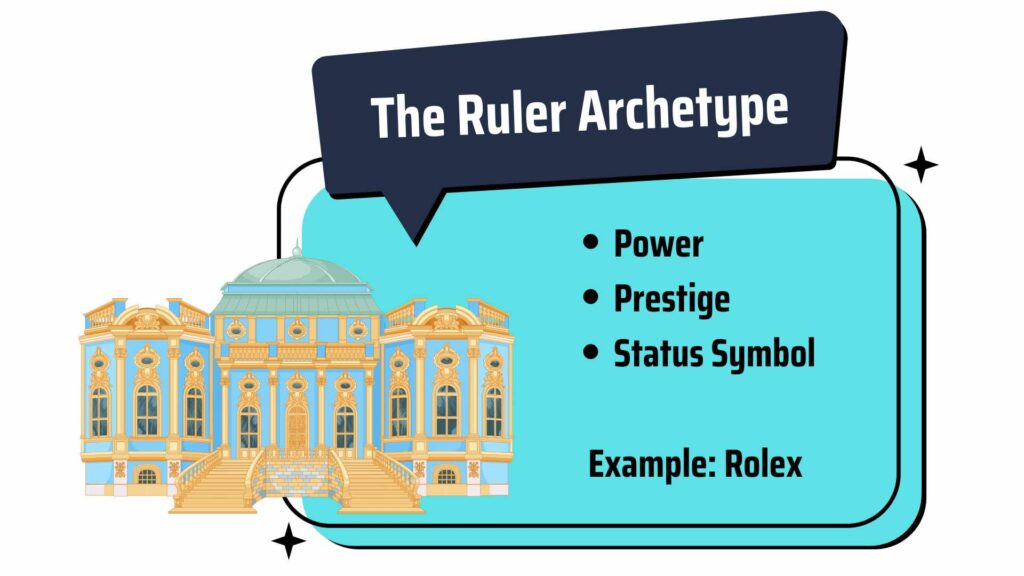
What does it stand for?
- Power, control, and luxury
- Status and prestige
- For those who value authority and seek leadership
Overview
The ruler brand archetype has something elegant in it.
Businesses fix on inspiring trust and loyalty among their people. They promote exclusivity and prestige.
This grabs the attention of those people who seek:
- Success
- Power, or
- Status symbol
A study shows that:
- “People generally find it attractive to be in a position of power.”
Brands target that emotion to connect with the individuals.
Example | Rolex
The ruler brand has always been the Rolex brand archetype.
It has earned popularity for its luxury watches. The reputation of the brand has come right from its heritage and rich history.
Moreover, their watch has all the positive factors like–
- Accuracy, craftsmanship, in-house manufacturing, and innovation.
These all add cherries on top.
Such factors make the brand reliable, and their status symbol works to entice collectors.
Their fanbase is pretty good. As per Statista:
- “45% of US watch users say– they like Rolex.”
Ad
For instance: Rewriting Tennis History is a powerful ad.
It portrays a strong emotion about owning the match. Featuring tennis star, Jennik Sinner, the ad beautifully shows her strength and dominance.
Frequently Asked Questions (FAQs)
Here’s a list of 12 brand archetypes: The everyman, innocent, hero, outlaw, caregiver, magician, lover, jester, sage, ruler, creator, and explorer.
Two great examples of customer archetypes are the bargain hunter and the security seeker.
It’s always the hero. Nike represents the Hero brand archetype since it focuses on adventure, struggles, and victory.
The innocent. Coca-Cola follows the innocent brand archetype. It emphasizes purity, happiness, and optimism.

Executive Producer at LocalEyes Video Production | Emmy Award Winning Producer

